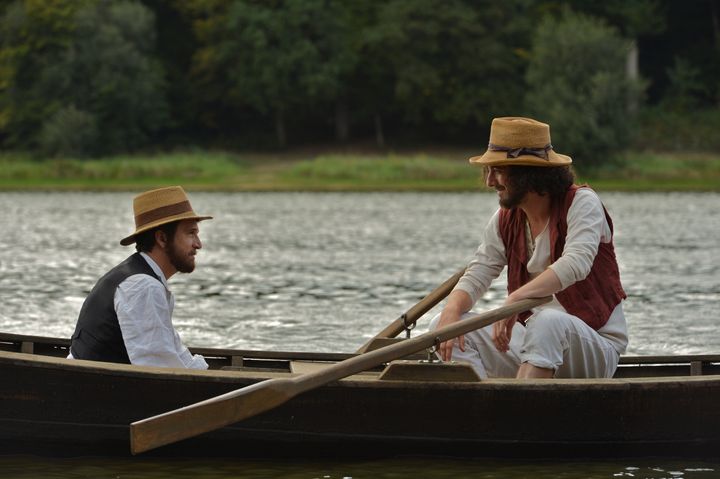
Guillaume Canet and Guillaume Gallienne in CÉZANNE ET MOI
We all have difficult friends. Some we’ve known since childhood. The fond memories and bonds we share keep us coming back even when we know it’s going to get ugly.
We hope for the best. Defend them when other friends attack them, and try to find a way to navigate the predictable unpredictability that casts a cloud on every encounter.
We’re not alone. The new film, Cézanne et Moi, by Danièle Thompson, brings to life the never before explored rollercoaster journey of the friendship between painter Paul Cézanne and author Emile Zola.
These two icons meet as boys in Aix-en-Provence and bond as playmates who share dreams about creating great art. There’s only one place for them and that’s Paris.
Zola had no money, so living the bohemian life in Paris isn’t a sacrifice. Cézanne, the son of wealthy banker, has to choose whether to follow his father’s dreams for him, working for the bank, or follow Zola to Paris.
Paris wins out. Cézanne’s father slashes his allowance and Cézanne and Zola dive into the bohemian culture of mid nineteenth century Paris. It’s the period made famous by Puccini’s La Bohème that was inspired by Henri Murger’s novel, Scènes de la vie de Bohème.
Zola, like La Bohème’s Rodolfo, is a writer who falls for an impoverished woman, a seamstress who sews flowers onto garments. Zola’s wife was a flower arranger and seamstress who may have also been a prostitute. Cézanne, is a painter, like Rodolfo’s friend Marcello.
These bohemians join the countless other young denizens who make up the flourishing art scene in post revolutionary Paris. Their quest is a timeless tale of alienated young people who leave the comforts of bourgeois society in order to follow their muse.
The two fit right in with a host of other impoverished, anonymous, rebellious young people who are daring to break convention in their quest for fulfillment through painting, writing or music.
They battle the establishment with gusto. Being accepted would be a sign of selling out. They celebrate their failures and forge a path forward.
Zola, like his counterpart Rodolfo, sees his career take off. His novels become huge successes and his life takes the path Murger witnessed for many of the Bohemians. He becomes a fixture among the bourgeoisie he once disdained and so artfully skewered in his novels.
His friend Cézanne continues to struggle, becoming increasingly disagreeable and often vicious. It’s a challenge for even the deepest friendships. Zola and Cézanne become estranged.
The film is framed by a visit Cézanne pays to Zola later in life. This attempt at reconciliation finds Zola at home in his palatial estate surrounded by all the trappings that signal his place in society. His office is a cocoon filled with fine carpets, sculpture, paintings and an elaborate desk where he writes.
We see the bond forged in childhood still exist but a lifetime of slights, arguments, missteps and disappointments are roadblocks to their reconciliation.
Neither party is blameless but Cézanne appears to be suffering from a bipolar disorder that refuses to allow him any peace and keeps any and all wounds open and festering.
The crux of the central dispute is the thinly veiled portrayal of a difficult artist like Cézanne, in Zola’s novel L'Œuvre (The Masterpiece, 1886).
An apology from Zola is not forthcoming and this rift cannot be healed.
Cézanne’s work is eventually recognized as being the link between the Impressionists and Modernism and Zola is revered, but they are never able to bridge the gap that keeps them from enjoying what is clearly a lasting friendship.
This beautiful film was shot in many of the locations Cézanne painted and its canvas is rich with the natural beauty he immortalized.
Guillaume Canet brings Emile Zola’s quest for success to life and Guillaume Gallienne captures the spirit of the tumultuous, vulnerable and driven Cézanne.
They are supported by a gifted group of women who portray these characters in Zola and Cézanne ’s lives. Alice Pol takes the character of Alexandrine Zola from a destitute young girl to the society matron. Deborah François, as Hortense Cézanne, is the beautiful woman who poses for Cézanne, bears him a son and after many years finally becomes his wife.
And then there are the mothers. Emile Zola’s mother played by Isabelle Candelier can never turn on Cézanne because to her he’s always a little boy.
Ann-Elisabeth as Cézanne ’s mother is the peace broker between Paul and his father. She always protects him and supports him when he imagines the world is lined up against him.
The wild card, Freya Mavor, as the young servant who works in the Zola home, captivates the author and complicates his settled life.
The director and writer Danièle Thompson weaves these pieces together with great art and a passion for complex people in challenging relationships who create lasting and memorable work. She’s done that here with a story she says shows, “friendship is sometimes more complicated than love.”
Cézanne et Moi opens in New York March 31.
In Los Angeles, Pasadena and Irvine on April 7 and Encino April 14
A Magnolia Pictures Release
Rating Pending
116 minutes
In French with English Subtitles
